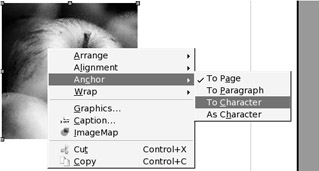Inserting Pictures
Writer includes quite substantial desktop publishing-like functions, such as the ability to insert pictures into text documents and to have text flow around pictures.
Inserting any kind of graphic—a graph, digital camera photo, drawing, or any other type of image—is easy. Simply choose Insert ®Graphics ®From File.
| Tip | If you have a scanner and have correctly installed the XSane program (see Chapter 8), you can also scan pictures into Writer documents. |
After you've inserted a picture, you can place it anywhere on the page. When you select the picture, a new toolbar appears. This toolbar contains various simple image-tweaking tools, such as those for altering the brightness, contrast, and color balance of the image. Additionally, by clicking and dragging the blue handles surrounding the image, you can resize it.
Graphics that are imported into Writer must be anchored in some way. In other words, they must be linked to a page element so that they don't move unexpectedly. By default, they're anchored to the nearest paragraph, which means that if that paragraph moves, the graphic will move, too. Alternatively, by right-clicking the graphic, you can choose to anchor it to the page, paragraph, or character it is on or next to, as shown in Figure 24-4. Selecting to anchor it to the page will fix it firmly in place, regardless of what happens to the contents of the surrounding text. The As Character option is slightly different from the To Character. When you choose As Character, the image will be anchored to the character it is next to, and it is actually inserted in the same line as that character, as if it were a character itself. If the image is bigger than the line it is anchored in, the line height will automatically change to accommodate it.

Figure 24-4. A picture can be "anchored" to the page, pa ragraph, or a character. This affects how it responds to the paragraphs surrounding it.
As you can see in Figure 24-4, the context menu also includes a Wrap option, which lets you set the type of text wrap you want to use. By default, No Wrap is selected, so the graphic will occupy the entire space on the page; no text is allowed on either side of it. Page Wrap is the best option if you're looking for a desktop publishing-style effect, because the text will wrap around both sides of the picture. Optimal Page Wrap causes the text to wrap down just one side of the picture, the side on which the picture is furthest from the edge of the page. Alternatively, if you wish the image to appear in the background of the page with text flowing across it, you can select the relevant option from the menu.
As always within OpenOffice.org, ultimate control is achieved by opening the relevant dialog box. You can set up how graphics are treated on the page by right-clicking the image and selecting Graphics. In the dialog box that appears, you can select the wrap effect, specify the invisible border around the wrap (which governs how close the text is to the image), and give the image a frame.
EAN: 2147483647
Pages: 293
- Structures, Processes and Relational Mechanisms for IT Governance
- A View on Knowledge Management: Utilizing a Balanced Scorecard Methodology for Analyzing Knowledge Metrics
- Measuring ROI in E-Commerce Applications: Analysis to Action
- The Evolution of IT Governance at NB Power
- Governance Structures for IT in the Health Care Industry